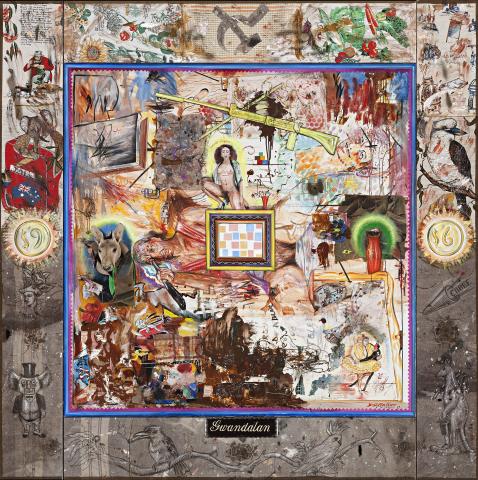MONOGRAM, 1989
JUAN DAVILA
oil and collage on canvas
280.0 x 280.0 cm
signed, dated and inscribed verso: “MONOGRAM” / JUAN DAVILA 1989
Kalli Rolfe Contemporary Art, Melbourne
Private collection, Melbourne
Juan Davila, Tolarno Galleries, Melbourne, 1989
Juan Davila, Museum of Contemporary Art, Sydney, 9 September – 12 November 2006; National Gallery of Victoria, Melbourne, 30 November 2006 – 4 February 2007
Brett, B. and Benjamin, R., Juan Davila, The Miegunyah Press, Museum of Contemporary Art, Sydney, 2006, p. 132 (illus.)
‘We seem to have lost the capacity to relate to any other culture or being but the Western one…. Social issues, disturbance, difference, misery, madness and strangeness are silenced by emphasising in the other only that which resembles us, or by distancing the other and its desire as alien, thus erasing the capacity of anyone to address or challenge us…’1
With his unswerving belief in the role of the artist as ‘provocateur’, for over four decades now Chilean-born artist, Juan Davila has consistently interrogated prevailing cultural, social and sexual identities to create an art that is as uncomfortable at times as it is compelling. Whether critiquing the Australian political system, the greed of late-capitalism, the oppression exerted by Western art history or the treatment of marginalised people in both Chile and Australia, his work is strident and confrontational, yet strangely seductive and always unforgettable – bestowing a lingering sense of disquiet and inevitably disturbing our world view.
Throughout his rich and varied oeuvre, one of Davila’s signature techniques has been his ‘cultural quotation style’ which juxtaposes allusions and references to other artists alongside the visual landscape of the street (comic strips, tarot cards, pornography, political cartoons etc). While this challenge to the ‘high-low’ divide is reminiscent of the Western avant-garde as espoused by Dada and Pop Art, importantly the strategy also evokes the hybrid modernism of his native Latin America which typically incorporates indigenous, colonial and external influences. Betraying contradictory qualities of refinement and tackiness, mimicry and invention, celebration and condemnation, Monogram, 1989 encapsulates the fragmentary implications of this ‘collage’ approach, invariably employed by the artist to promote uncomfortable ambiguity and create subtle shifts in perception.
Overwhelming both in their scale and myriad cast of art world identities, Davila’s elaborate tableaux from 1989 (including Retablo, Hybrid and The Barricade) are undeniably considered among the most powerful of his career – and certainly, Monogram is no exception. A direct parody of the ‘combine’ painting of the same name by Robert Rauschenberg in which the American artist juxtaposes the taxidermied head of a goat (here Davila employs a kangaroo instead), indeed Monogram illustrates well Davila’s use of mimicry as a strategy of reinvention through the recombination of cultural forms. In the same vein for example, Davila comically conflates Brack’s signature ballroom dancers with his feted portrait of Fred Williams in the collection of the Art Gallery of South Australia; performance artist Mike Parr appears with his head anamorphically distorted; and fellow South-American social realist, Antonio Berni, is referenced in the figure of Juanita Laguna (a fictional character from his collaged narratives condemning the poverty engendered by neocolonialism in Argentina) – to list but a few of the many allusions to the ‘art economy’ incorporated by Davila as ciphers to be decoded. Moreover, the dismantling of pictorial unity that occurs through the collision of so-called ‘high art’ with mundane imagery here (Australian memorabilia from literature and advertising, kitchen linen reproductions etc) not only forces the viewer to question the hierarchies applied to images, but serves to undermine the power historically accorded to the artist as the originator of art’s fixed meanings, and ultimately, to de-stabilise the Western tradition as the dominant cultural narrative.
Highly respected for his resonant social voice, Davila has exhibited widely throughout Australia, South America, North America and Europe since the 1970s. His work was included in the 1982 and 1984 Biennales of Sydney and the 1998 Bienal de São Paulo, Brazil, and featured prominently in Documenta 12, Kassel, Germany, in 2007. In 2006, a major retrospective exhibition was held at the Museum of Contemporary Art, Sydney and National Gallery of Victoria, Melbourne, while other notable recent achievements include The Moral Meaning of Wilderness, Monash University Museum of Art, Melbourne, 2011 and the non-acquisitive Benalla Nude Art Prize which he was awarded in 2014. Today his work is held in all major public collections throughout Australia, as well as the Metropolitan Museum of Art, New York and Museo Extremeno e Iberoamericano de Arte Contemporaneo, Madrid.
1. Davila, J., ‘A Brief Commentary by the Artist’ in Juan Davila: Works 1988-2002, The Australian National University Drill Hall Gallery, Canberra, 26 September – 3 November 2002, p. 13
VERONICA ANGELATOS
